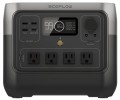Add to comparison |  |  |
|---|---|---|
| EcoFlow RIVER 2 Pro | BLUETTI PowerOak EB70 | |
| Compare prices 5 | from $369.00 | |
| User reviews | ||
| TOP sellers | ||
3 USB A ports, 1 USB C port. Car cigarette lighter, DC5521 port, XT60 port. Surges up to 1600 W are allowed. LFP (LiFePO4) – lithium iron phosphate battery. | 2 USB A ports, 2 USB C ports. Car cigarette lighter port DC5521. Jumps up to 1400 W are allowed. LiFePo4 battery. Wireless charging power 15 W. Flashlight | |
| In box | charging station | charging station |
| Rated power | 800 W | 1000 W |
| Peak power | 1600 W | 1400 W |
| Output waveform | sinusoid (PSW) | sinusoid (PSW) |
| UPS function | ||
Outputs | ||
| Sockets (230 V) | 3 | 2 |
| USB A | 3 5В/2.4А 12 W | 2 5В/3A 15 W |
| USB C | 1 5 A 100 W | 2 3 A, 5 A 100 W |
| Wireless charger | 1 zone 15 W | |
| Car cigarette lighter | ||
| DC output | 2x DC5521 (12.6 V / 3 A / 36 W) | |
Inputs (station charging) | ||
| From solar panels | ||
| Via USB-C | ||
| Input port XT60 | ||
Battery and charging time | ||
| Battery type | LiFePO4 | LiFePO4 |
| Battery capacity | 768 W*h | 716 W*h |
| Charging cycles | 3000 | 2500 |
| Charging time (socket) ≈ | 70 min | 240 min |
| Charging time (solar panel) ≈ | 210 min | 360 min |
| Charging time (cigarette lighter) ≈ | 461 min | 480 min |
| Charging power (socket) | 940 W | 200 W |
| Charging power (solar panel) | 220 W | 200 W |
| Charging power (cigarette lighter) | 100 W | 100 W |
General | ||
| Smartphone synchronization | Bluetooth and WiFi | |
| PSU | built into the body | external |
| Display | ||
| Backlight | ||
| Carrying handle | ||
| Operating temperature | 0 °C ~ +45 °C | 0 °C ~ +40 °C |
| Dimensions | 226x270x260 mm | 221x320x216 mm |
| Weight | 7.8 kg | 9.7 kg |
| Warranty | 5 years | 2 years |
| Added to E-Catalog | november 2022 | september 2022 |
Charging stations EcoFlow RIVER 2 Pro and BLUETTI PowerOak EB70 each have their strengths and weaknesses. The EcoFlow RIVER 2 Pro stands out with a high rated power of 800W and a peak power of 1600W, allowing for the connection of more powerful devices. Users highlight its fast charging (70 minutes from the mains) and convenient management app, as well as an informative display. However, some users wish for a larger battery capacity. Meanwhile, the BLUETTI PowerOak EB70 offers 1000W (800W for 120V) power but has slower charging (240 minutes from the mains) and fewer outputs. Users note that it can work with household appliances, but its reliability raises concerns, especially after unfortunate warranty experiences. Overall, the EcoFlow RIVER 2 Pro seems to be a more preferable choice for those seeking a powerful and fast charging station, while the BLUETTI PowerOak EB70 might be suitable for less demanding tasks.